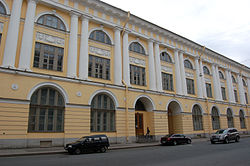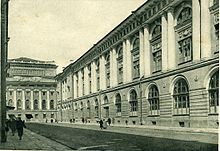Vaganova Academy of Russian Ballet
This article needs additional citations for verification. (September 2014) |
| Vaganova Academy of Russian Ballet | |
|---|---|
 | |
| Location | |
 | |
| Coordinates | 59°55′49″N 30°20′09″E / 59.9303°N 30.3358°E |
| Information | |
| Type | Ballet school |
| Established | May 4, 1738 |
| Campus type | Urban |
| Website | https://vaganovaacademy.ru/ |
The Vaganova Academy of Russian Ballet is a school of classical ballet in St Petersburg, Russia. Established in 1738 during the reign of Empress Anna, the academy was known as the Imperial Ballet School until the Soviet era, when, after a brief hiatus, the school was re-established as the Leningrad State Choreographic Institute. In 1957, the school was renamed in honor of the pedagogue Agrippina Vaganova, who cultivated the method of classical ballet training that has been taught there since the late 1920s. Many of the world's leading ballet schools have adopted elements of the Vaganova method into their own training.
The Vaganova Academy is the associate school of the Mariinsky Ballet, one of the world's leading ballet companies. Students of the school have found employment with ballet and contemporary companies worldwide, such as the Bolshoi Ballet, The Royal Ballet, American Ballet Theatre and the Mikhailovsky Ballet.
History
[edit]The school was established as the Imperial Theatrical School by decree of the Empress Anna on 4 May 1738[1] with the French Ballet Master Jean-Baptiste Lande as its director. The first classes occupied empty rooms in the Winter Palace in St. Petersburg and the first students were twelve boys and twelve girls.

Nearly all the early teachers at the school were from Western Europe, including Franz Hilferding and Giovanni Canzianni. The first Russian teacher to join the school was Ivan Valberg. After the spread of ballet in Europe, the development of the school was influenced by a number of other teachers and methods, including Christian Johannson, a student of August Bournonville, and the Italian methods of Enrico Cecchetti, Pierina Legnani and Carlotta Brianza. Other renowned 19th-century dancers and ballet masters who taught at and were influential in the development in the school include Charles Didelot, Jules Perrot, Arthur Saint-Léon, Lev Ivanov, Marius Petipa and Mikhail Fokine.[citation needed]
Since 1836, the school has been situated at 2 Rossi Street in St. Petersburg (known as Leningrad after 1924 until the collapse of the Soviet Union). The Imperial Ballet School was dissolved by the new Soviet government, but later re-established on the same site as the Leningrad State Choreographic School. The Imperial Russian Ballet was also dissolved and re-established as the Soviet Ballet. The company was later renamed the Kirov Ballet following the assassination of Sergey Kirov in 1934. Despite in 1992 being given the current name Mariinsky Ballet, the company is still commonly known as the Kirov Ballet.[citation needed]
Vaganova
[edit]
Agrippina Vaganova brought developments in modern Russian Ballet. She graduated from the Imperial Ballet School in 1897 and danced with the Imperial Ballet, retiring from the stage early to pursue her teaching career following the Revolution. As the Soviet government had not yet re-established the school, Vaganova began her teaching career at the privately owned School of Russian Ballet, eventually joining the new Leningrad State Choreographic School in 1920. Vaganova is noted for authoring The Principles of Classical Dance, which outlines the training system she created. There are a number of variations in the name of the school, but the official title in current use in the English-speaking world is Vaganova Ballet Academy.
Today
[edit]Overview
[edit]The Vaganova Ballet Academy which some consider the source of modern ballet is now over 275 years old.[2] The Academy has over 300 students. The Rector of the academy is Nikolay Tsiskaridze and the Artistic Director is Zhanna Ayupova.
Auditions
[edit]Auditions for the school begin in June, and children must be at least 10 years old to audition.
Training
[edit]All students at the school begin by studying a program of dance training, secondary school level education, French language and piano lessons. As they progress through the school, the program becomes more intensive, with new subjects being added to the curriculum as the students become more advanced. Students are evaluated at the end of each academic year and a decision made as to whether they will advance to the higher grades which have progressively fewer openings.[3]
Notable graduates
[edit]- Svetlana Adyrkhaeva
- Altynai Asylmuratova
- Zhanna Ayupova
- George Balanchine
- Emira Amzai
- Mikhail Baryshnikov
- Vakhtang Chabukiani
- Alexandra Danilova
- Natalia Dudinskaya
- Valentin Elizariev
- Mikhail Fokine
- Ai-gul Gaisina
- Elizaveta Gerdt
- Eleonora Sevenard
- Yuri Grigorovich
- Tamara Karsavina
- Maria Khoreva
- Ji-Young Kim
- Irina Kolpakova
- Alexandra Koltun
- Gabriela Komleva
- Ekaterina Kondaurova
- Mathilde Kschessinska
- Nicolai Legat
- Serge Legat
- Larissa Lezhnina
- Ulyana Lopatkina
- Lisa Macuja-Elizalde
- Natalia Makarova
- Yulia Makhalina
- Ryan Martin
- Varvara P. Mey
- Galina Mezentseva
- Fethon Miozzi
- Olesya Novikova
- Bronislava Nijinska
- Vaslav Nijinsky
- Rudolf Nureyev
- Aaron Osawa-Horowitz
- Valery Panov
- Yelena Pankova
- Veronika Part
- Anna Pavlova
- Olga Preobrajenskaya
- Evgenia Obraztsova
- Anna Odintsova
- Farukh Ruzimatov
- Marina Semenova
- Konstantin Sergeyev
- Vladimir Shklyarov
- Alla Sizova
- Olga Smirnova
- Yuri Soloviev
- Alina Somova
- Olga Spesivtseva
- Yulia Stepanova
- Viktoria Tereshkina
- Galina Ulanova
- Anastasia Volochkova
- Diana Vishneva
- Rostislav Zakharov
- Svetlana Zakharova
- Konstantin Zaklinsky
- Igor Zelensky
- Anastasia Smirnova
References
[edit]- ^ "Vaganova Academy – History of the Vaganova Ballet Academy". vaganovaacademy.ru. Retrieved 2024-02-07.
- ^ Russian Ballet Celebrates 275 (!!!) Years Archived 2014-03-13 at the Wayback Machine, Dance Magazine, 2013, retrieved 13 March 2014
- ^ NHK Documentary, "Future Princes of Ballet."
External links
[edit]- Official website (in English)
- Official website (in Russian)
- Photo-essay: Vaganova Ballet Academy

